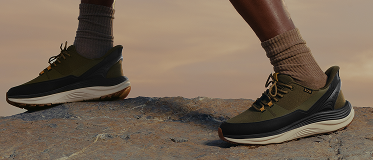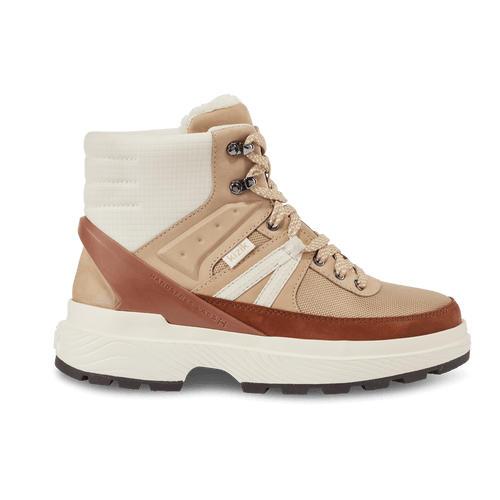Have you ever stumbled on a pair of shoes labeled “EP” and wondered what it means? You’re not just looking at another obscure acronym—this is your first glimpse into the world of specialty footwear.
Here at Kizik, we know that every label contains vital information about a shoe’s fit and function, and EP is no exception. This tag can be your golden ticket to better performance and tailored support, especially if your shoe game involves more than casual strolls.
What does EP stand for in shoe sizing?
When you see “EP” on a shoe box, you're looking at the designation for "Engineered Performance." This isn't your average shoe size marker—it’s a nod to shoe designs that are specifically crafted to enhance athletic performance.
EP pairs are built to optimize every shoe element to support specific sporting activities, from basketball to long-distance running, which ensures that every component serves a purpose to upgrade your performance.
Who typically needs EP shoes?
EP shoes are a go-to for athletes whose footwear must go beyond the ordinary. Here's a snapshot of what EP sneaker users are:
- Competitive athletes: For those serious about their sport, EP shoes offer the precision and the tech specs necessary for high-level performance.
- Fitness enthusiasts: If you regularly hit the gym or enjoy weekend sports, these shoes provide an extra edge in support and comfort.
- Active professionals: EP shoes can deliver comfort and endurance throughout the day if your job requires dynamic movement or long hours on your feet.
If your feet are crying out for additional support on the track or in the gym, then EP shoes are what you need to step up your game.
How does EP compare to other shoe sizes?
How does EP stack up against the many other shoe sizes that line the shelves? Here’s a run-down to help you see where EP fits in:
EP vs. standard sizes
- Standard sizes (B, D, etc.): Your go-to widths for everyday wear. B represents a standard width for women and D for men.
- EP: These offer a specialized fit beyond width to elevate your performance through tailored support to your athletic needs.
EP vs. wide sizes (E, EE, EEE)
- Wide sizes: These provide increased room across the foot to accommodate wider feet or those needing more space.
- EP: While it may offer a bit more width than standard, its primary focus is on performance enhancements rather than simply providing more space.
EP vs. narrow sizes (A, AA)
- Narrow sizes: Specifically designed for narrower feet, these ensure a snug fit that doesn’t slip during movement.
- EP: Due to their performance-oriented design, EPs may actually feel more snug than standard, but they aren’t typically as narrow as A or AA widths.
EP vs. specialty athletic sizes
- Specialty athletic sizes: Like EP, specialty athletic sizes are designed with specific sports in mind. However, they might not emphasize overall foot support and dynamics as much as EP.
- EP: Engineered to optimize performance in every aspect, from stability during lateral moves to cushioning impacts. That makes them ideal for a wide range of sports and active lifestyles.
With EP shoes, you’re not just getting a shoe that fits. Instead, you’re stepping into shoes that are crafted to elevate your athletic performance every step of the way.
What are the key features of EP shoes?
You've got the lowdown on what EP stands for and how it measures up against other options. But what exactly makes a shoe EP? Let’s pull back the curtain and explore the standout features that define EP footwear:
Superior cushioning
A hallmark of EP shoes is their superior cushioning, designed to absorb impact during high-energy activities. Each step feels cloud-like, while the cushioning protects your joints and muscles.
Strong support
EP shoes provide solid support, engineered to keep your foot stable and aligned, lowering injury risk. Perfect for active wear, they keep up whether you're on the court or running trails.
Breathable materials
EP shoes use advanced, breathable materials to keep feet cool and dry, promoting air circulation and wicking away moisture for an optimal performance environment.
Flexible fit
Flexibility in EP shoes allows natural foot movement while maintaining support. They adapt easily to various motions and surfaces, seamlessly handling different activities.
Durable construction
EP shoes are built to withstand an active lifestyle, using durable materials and reinforcement in high-wear areas for long-lasting dependability.
How to find the best EP shoes
Convinced you need EP shoes? Finding the perfect pair can feel like a quest, but once you do, it’s a serious performance upgrade. Here’s how to get your ideal match:
Dive into the details
Start with the specs. EP shoes are precision-engineered, with each element enhancing performance. Look for features that suit your sport, like extra cushioning for runners or reinforced soles for basketball players.
Feel the fit
Nothing kills a good game quicker than a bad fit. Make sure your EP shoes hug your feet in all the right places without cramping your style—or your toes. They should enhance your movements, providing a supportive but unrestrictive experience that feels as natural as walking barefoot.
Embrace the tech
When shoes are smarter than ever, why settle for less? Luckily, EP shoes often pack a punch when it comes to the latest tech. Think moisture-wicking materials, energy-returning soles, and yes, even some that slip on without a struggle.
For a slick blend of tech and convenience, check out our hands-free slip-on shoes. They’re the kind that gets you out the door at superhero speed—no hands required!
Test their temperament
Do your EP shoes match your lifestyle? Whether you’re hitting indoor gyms or running outdoors, choose a pair that can keep up with your pace and flex with your moves day after day.
Listen to the legends
Sometimes, the best advice comes from other athletes. Check reviews, ask your sports community, and see what’s popular. If an EP shoe has a fan base, it’s worth a look.
How to care for EP shoes
You’ve got EP shoes built for high performance—now keep them looking and working their best. Whether on a muddy trail or daily grind, proper care ensures they go the distance.
Clean regularly to avoid build-up
The first rule of shoe care is cleanliness. Dirt and dust can impact both the look and performance of your EPs. Use a soft brush or damp cloth to remove surface debris after each wear. For mesh or knit, clean gently to avoid snags.
Store them properly
After a long day, don’t just toss them aside. EPs are durable but need care off-duty. Store in a cool, dry place, use shoe trees if possible, and avoid stacking heavy items on them to keep their shape.
Protect them from the elements
Rain and stains are inevitable, but they don’t have to ruin your EP shoes. If you're heading out into unpredictable weather, protect your pair from water damage by spraying the Rain & Stain Guard from our Shoe Care Kit.
Whether it’s knit, mesh, leather, or microfiber suede, this guard creates a barrier that helps keep your shoes looking fresh and clean. Plus, it’s an easy way to keep those dreaded stains at bay.
Rotate your shoes
We know you love your EP shoes, but giving them a break helps extend their lifespan. Rotating pairs allows each to air out and recover, preventing odors and wear—your shoes (and feet) will thank you!
Keep them fresh
Nobody wants stinky shoes. Keep your EP shoes smelling as fresh as they look by using a deodorizing spray or natural alternatives like baking soda. Simply sprinkle a bit of baking soda inside after you wear them, leave it overnight, and shake it out in the morning. It’s an easy hack to keep your kicks smelling clean and ready for action.
The final word
EP stands for "Engineered Performance," built for athletes seeking peak performance and durability. At Kizik, we blend comfort and function with hands-free slip-ons—no laces, no fuss, just effortless style and performance. Step into smarter footwear with Kizik and feel the difference engineered shoes make.
Sources:
Long-distance running | Definition, History, & Facts | Britannica
How to Stop Shoes From Smelling | Consumer Reports
Why Good Footwear is So Important for Your Health | CHP
Life's Essential 8 - How to Be More Active Fact Sheet | American Heart Association






























Leave a comment
This site is protected by hCaptcha and the hCaptcha Privacy Policy and Terms of Service apply.